
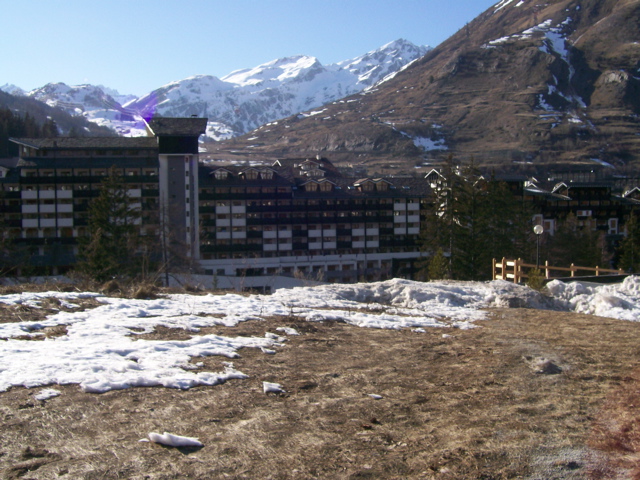
A Field Guide to Venus
Venus has an Earthlike mass and surface gravity, the latter being 8.9 meters per second per second, only slightly less than Earth’s. Venus is in a very nearly circular orbit about the Sun with orbital period (year) equal to 224.65 Earth days. Venus rotates much more slowly than Earth, however, and this has many consequences for the atmospheric dynamics, since it greatly reduces the Coriolis accelerations that do so much to organize Earth’s large scale atmospheric circulations. In fact, the rotation of the planet is retrograde — i.e. opposite in direction to the rotation of the orbit. The siderial day on Venus — the period with which the star patterns would repeat, if you could see the stars from the surface — is 243 Earth days, but since this is in the retrograde direction, it adds to the angular velocity of the planet relative to the Sun. Thus, the rate of rotation relative to the Sun is 1/224.65 + 1/243 rotations per Earth day, leading to a solar day of 1/(1/224.65 + 1/243), or 116.7 Earth days. This is the time between sunrises, as would be seen from the planet’s surface. Thus, Venus’ solar day is roughly half of its year, as illustrated in the sketch below (credit K. Fuller).
You might think that the long day would result in the dayside heating to extreme temperatures while the darkness-plunged nightside plummeted to relatively frigid values. In fact, because of the dense 92 bar atmosphere, it takes a very long time for most of the atmosphere to heat up or cool down, and there is little day/night variation over most of the depth of the atmosphere. Higher up, however, there is a diurnal and seasonal cycle, as illustrated by the black vs. green lines in the accompanying sketch — Venus Express in fact found indications that the diurnal cycle extended deeper into the atmosphere than this traditional sketch suggests, with significant temperature variations penetrating to 45 km. altitude. The atmosphere of Venus is nearly pure carbon 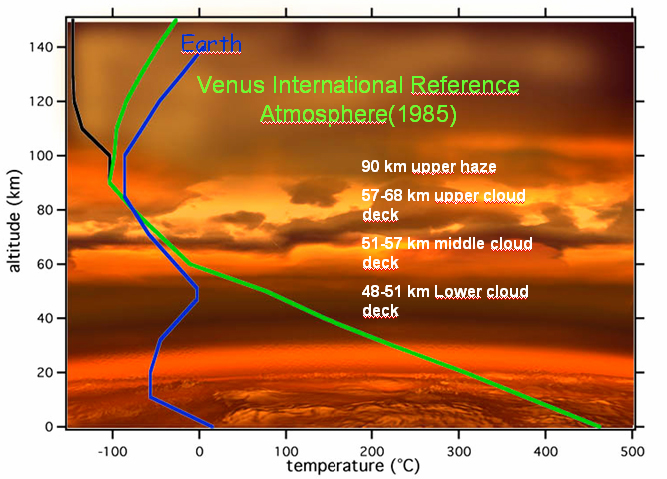
The VEX instruments
For a full list of the complement of instruments on Venus Express you can take a look at the VEX Instrument Summary .For the most part, I’ll focus on data from VIRTIS and SPICAV-SOIR. VIRTIS is a spectral imager which observes patches of Venus in a set of wavelengths ranging from the ultraviolet (0.25 microns) to the near infrared (5 microns). On the night-side VIRTIS infrared yields thermal emission, which can provide information about cloud structure and temperature, as well as information about atmospheric constituents.. On the day-side VIRTIS infrared images are dominated by reflection of the near-infrared component of sunlight; the absorption of solar near-infrared also provides valuable information about atmospheric constituents, as well as information about cloud structure that is complementary to the night-side thermal emission. SPICAV/SOIR is a spectrometer with somewhat different characteristics; it returns high-resolution ultraviolet images , which reveal interesting aspects of atmospheric dynamics. The reflection of short wavelengths like ultraviolet gives a good indication of the occurrence of cloud particles, but the utility of ultraviolet observations is enhanced by the presence of an as-yet unidentified ultraviolet absorber in the atmosphere of Venus, which shows up in the form of dark streaks on ultraviolet images. Besides being useful as an ultraviolet imager, SPICAV/SOIR is used with a technique called occultation, in which the attenuation of starlight or sunlight passing through the atmosphere provides information about the vertical profile of various atmospheric constitutents, including sulfur dioxide, water vapor (and its various isotopes), carbon monoxide, carbonyl sulfide and oxygen. SPICAV is derived from spare parts from a similar instrument (SPICAM) that flew on Mars Express, but SOIR, which adds infrared channels useful for solar occultuation measurements, was newly developed for Venus Express.
Venus Express also carried a thermal infrared spectrometer, PFS, which was intended to study wavelengths longer than 5 microns. Thermal emission in these wavelengths is important to the understanding of the radiation budget of Venus. Unfortunately, this instrument was the one disappointment in an otherwise spectacularly successful mission, as the PFS was rendered inoperative by the failure of a critical shutter to open. But no worries — the instruments that did work provide a great wealth of new material to think about.
Venus Express sports a lightweight radio-science package, VeRa. Radio occultation is a low tech but highly valuable workhorse of planetary observation. By observing the refraction of radio waves passing through the atmosphere, one can obtain density profiles, since the index of refraction is proportional to density. From density and the hydrostatic relation (i.e. pressure is the weight of all the fluid above you) it is possible to reconstruct temperature profiles if you know what the atmosphere is made of. On Venus, radio occultation can observe the atmosphere down to about 45 km. altitude from the surface.
Venus: A dynamic atmosphere
Venus is not the featureless cue-ball you’d think it is from low-resolution observations in the visible spectrum. 
Now let’s take a look at some of the circulation patterns revealed by Venus Express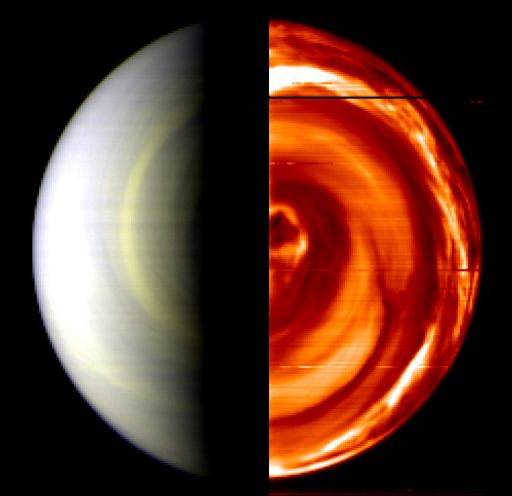
The South Polar vortex shows a dipole pattern very much like has been seen earlier at the North Pole. Here’s an example of the evolution, viewed by VIRTIS in an infrared channel thought to be mostly responding to cloud top height (see ‘South-polar features on Venus similar to those near the north pole’ by G. Piccioni et al. Nature,29 November 2007.) The vortex you are seeing is about 2000 km. across.
And this color image of the vortex, taken in the 5 micron band, shows the dipole structure more clearly. The bright yellow region is the dayside.
Although the surface of Venus rotates only slowly, the upper atmosphere has taken on a rotation rate of its own, and air around the 50km level circles the planet with a period of roughly 5 days. This is called super-rotation, because the rotation is in the same sense as the rotation of the planet, but stronger. It allows the upper atmosphere to support substantial temperature gradients, by providing a Coriolis acceleration which can offset pressure gradients associated with temperature variations. The super-rotation is not actually a rigid-body rotation, but has a very distinctive profile in latitude. Venus Express has provided new
In a related notable result, the modelling team from the Laboratoire de Meteorologie Dynamique, Paris has achieved a very convincing simulation of super-rotation in a new Venus general circulation model. Though the deep atmosphere of Venus is sluggish, its dynamics is nonetheless crucial since it is this circulation which brings angular momentum from the surface to the upper atmosphere; this circulation is also critical for atmospheric chemistry, since it transports gases to the surface where they can react to form minerals, and (more speculatively) transports volcanic outgassing to the cloud deck.
Higher in the atmosphere, the extreme temperature difference between the dayside and the nightside, due to solar absorption in the atmosphere on the dayside, drives a circulation flowing from the hot dayside to the cold nightside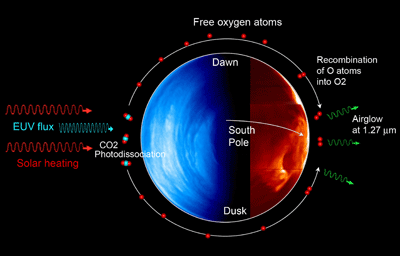
Venus atmospheric chemistry: The cloud deck
Using occultation methods, Venus Express has shed far more light on atmospheric chemistry than I can begin to go into here, but I will at least mention a few of the results. Quite remarkably, the remote-sensing techniques can detect not only the profiles of water vapor in the atmosphere, but also the various isotopes, notably the heavier version — deuterated water, HDO, in which deuterium substitutes for one of the hydrogens. In the Earth’s upper atmosphere, the HDO to H2O ratio is depleted relative to the water vapor in the lower atmosphere, because the heavier HDO condenses out more readily when it rains. On Venus, the situation is the opposite, and HDO is greatly enriched relative to lower level water vapor. This occurs because water vapor is broken apart by sunlight, and the lighter hydrogen escapes more readily than the heavier deuterium. Venus Express also found, though, that oxygen is escaping from the atmosphere in the ratio expected from breakup of water, suggesting that non-thermal escape processes in which chemical reactions give an extra kick to atoms, are important. Putting together a consistent picture which simultaneously accounts for the oxygen escape and the deuterium enrichment will tell us much about the mechanisms by which planets lose atmospheres, and perhaps shed light on issues affecting habitability of extrasolar planets.
Because the sulfuric acid cloud deck has such a profound impact on the climate of Venus, the chemistry of the Venusian sulfur cycle is of great interest. What is the lifetime of the clouds, absent resupply? Venus Express measurements, and associated laboratory experiments, are helping to clarify these issues as well. Carbonyl Sulfide has been observed in the atmosphere, and there are good indications that the formation of polysulfur (S2, S4, etc.) and possible subsequent precipitation plays a role in the sulfur cycle. The nature of sulfur dioxide resupply connects up with the contentious issue of catastrophic resurfacing of Venus, which I’ll take up shortly.
Peeking at the surface
With such a thick CO2 atmosphere, you’d think it would be utterly impossible to see the surface of Venus in the infrared. The issue of "saturation" of the absorption of infrared by CO2 has been discussed previously on RealClimate, but it turns out that even with 92 bars of CO2 in the atmosphere, Venus is not saturated throughout the infrared spectrum. There is a narrow window region in the vicinity of 1 micron wavelength, which allows the surface to be observed in the infrared. Venus Express has exploited this window to make maps of infrared emission from the surface, which, combined with topography data from the Magellan radar altimiter, allow an estimate of surface emissivity. Hopefully, this will shed some light on the minerology of the surface, which is largely mysterious. Just as a sample of the new data, here is an image showing the surface brightness anomaly overlain with radar topography. This image comes courtesy of Joern Helbert and his student Nils Müller, and of course as for all results derived from VIRTIS, the VIRTIS P.I’s Giuseppe Piccioni and Pierre Drossart deserve a round of applause as well.
One of the most exciting questions concerning the nature of Venus is whether the planet has undergone catastrophic resurfacing in the relatively recent past.. Venus has no plate tectonics to gradually engulf part of the surface. Unlike Earth or Mars, impact craters are uniformly distributed over the surface. By some reckonings, there appear to be no old craters, as witnessed by the apparent lack of craters in a state of partial degradation. This would argue for the entire surface having been engulfed or flooded over with magma some time in the past half billion years or so. However, the morphology of the surface lends itself to varying interpretations, and these were the subject of a genteel debate between David Grinspoon (for resurfacing) and Sue Smrekar (in the opposing camp). I can’t say that anybody struck a knockout blow, but it was certainly informative, and serves as another example of the way real scientists try to hash out uncertainties and conflicting theories. There is no herd mentality here, any more than there is in studies of Earth’s climate. It’s in the DNA of scientists to poke at theories all the time, and never cease their questioning. “Consensus” does not consist in agreeing on everything, but rather in agreeing on a common set of tools and methodologies, as well as on a set of results that can be considered settled to a sufficient degree that further results can be confidently built upon them. Consensus of this sort exists for Venus as well as for Earth, and nobody makes a fuss about it.
The question of resurfacing has major implications for the climate history of Venus. No active volcano has yet been observed on Venus, and it has been conjectured by David Grinspoon that perhaps Venus goes through cycles of extreme volcanism and sulfur resupply to the cloud-deck, followed by long quiescent periods in which the clouds dissipate and leave the planet’s surface much hotter than its already torrid temperature. This is indeed a frontier area of planetary science, and one which engages phenomena extending from the interior to mineral reactions at the planet’s surface, and onward to photochemistry in the outer reaches of the amosphere.
The Earth seen from Venus: A Pale Blue Dot
Modern planetary probes are so versatile they can be re-programmed to do things their original designers never anticipated. With colleagues at the University of Chicago, I’m doing that now, using a minerology probe on the Spirit and Opportunity rovers on Mars to examine atmospheric argon. Taking a leaf from the Pale Blue Dot observations of Earth from Galileo, popularized by Carl Sagan (look. here. for a detailed report of those observations), Venus Express mission scientists have gotten the bright idea of using observations of Earth from Venus to test methods for searching for habitable extrasolar planets. The next generation of extrasolar planet-finders will return spectra of the planets averaged over the entire planetary disk, so learning how to make the most of "single pixel astronomy" is of the utmost importance.
Already, observation of the Earth spectrum by VIRTIS has detected Earth’s CO2, oxygen and water vapor. Observations by SPICAV show the absorption feature characteristic of ozone. Work is underway, spearheaded by Darren Williams, to see if Earth’s oceans can be detected through the characteristic sun glint they produce.
At the meeting I also had the pleasure of meeting Enric Pallé, a young astronomer who is probably best known to regular RealClimate readers for his attempts to estimate trends in Earth’s albedo through ground-based measurements of lunar Earthshine. . Enric’s connection with the Earth from Venus session comes about because he has been looking at ways to measure a planet’s length of day by examining fluctuations in reflected sunlight; he has also been trying to detect Earth’s vegetative "red edge" through Earthshine observations. Enric tells me that he has refined his somewhat controversial Earth albedo estimates, and these no longer show the mysterious and striking long-term albedo trends reported in the original paper. To tell the whole story, though, I should note that the satellite based CERES albedo estimates (which showed an opposite trend to Earthshine) have evidently also been revised, owing to discovery of a drift due to deterioration in a filter. We’ll have to wait for Enric’s paper to see the details, but estimates of albedo fluctuations appear to be converging, according to preliminary results he showed me. This is science at its best, and a reminder both that detecting trends from satellites is difficult, and that one should avoid building elaborate and earthshaking interpretations on data from novel observing techniques like Earthshine until they have time to mature. We all could have been spared a lot of grief if the Alabama boys who pushed their erroneous microwave satellite temperature trends over surface records for so long had been as diligent as Enric in re-examining their methods.
What a week!
All in all, quite a week! And despite the lack of good snow on the cross-country trails, I did manage to get in a few nice excursions up the valley, with the help of a prodigious supply of red klister. I am looking forward to seeing what another year of Venus Express observations brings.
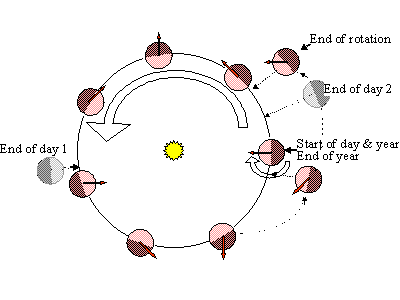
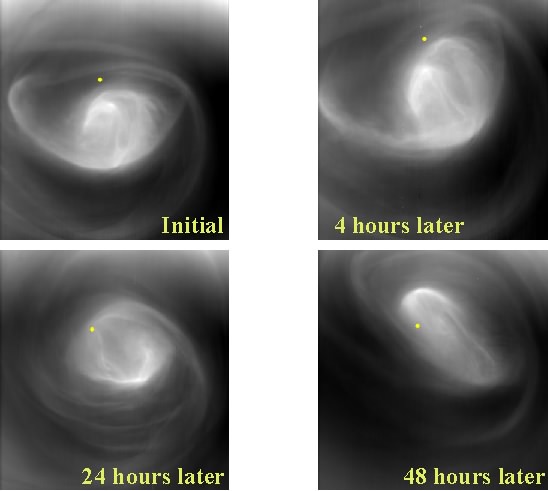
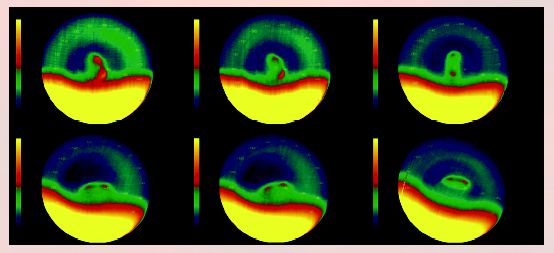
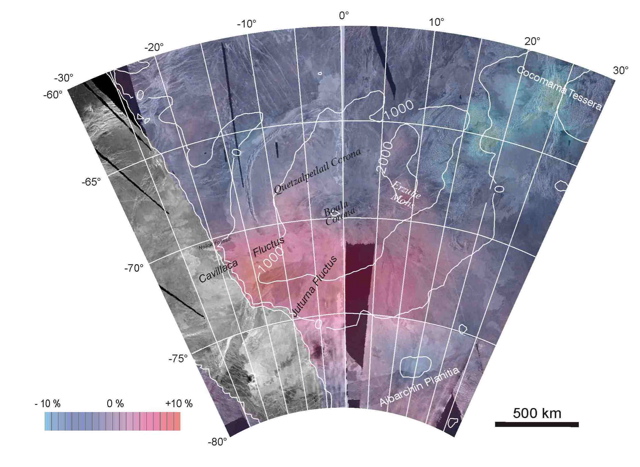
OK, here is a crazy idea. Please tell me why it wouldn’t work (I am a layman). Would it be possible to geo-engineer a plant that does photosynthesis and could survive in that temperature? Some type of GMO cactus perhaps? Then send an unmanned ship to Venus to plant said cactus. The plant would then start converting all that CO2 into O2, and reproducing. At some point, then you could test the theory of whether the atmosphere would cool as the CO2 concentration (965,000 ppm) came down. I guess one problem, other than getting there, would be if the plant could survive 116 days without sunlight.
[Response: Water is going to be a problem. If it weren’t for the lack of water and the high acidity in the clouds, I’d say the place to start is not at the surface, but with some kind of cloud-deck airborne cyanobacteria. It’s colder there. You’d want something that would make a very refractory form of organic carbon, and which would clump together and reach the surface. As things cool further it would work its way down. However, even apart from the water (which is needed for oxygenic photosynthesis to work), you have a problem with this scheme since you wind up with as many moles of O2 as you started with CO2, and that’s pretty deadly at the resulting surface pressures (exercise to the reader: compute the resulting surface pressure). That’s why it would be better to convert the CO2 into carbonate instead (at the surface this would happen by reaction with silicate rocks). No matter what, at some point you’re going to need to bring in a lot of water. An advantage of the cloud deck idea is that you wouldn’t need to bring in enough water to make an ocean, just enough to give you water clouds at the cloud level. Getting airborne cyanobacteria to precipitate carbonate shells using what’s available in the clouds is going to be tricky, though. All this is just science fiction, of course, but it’s still stimulating to think about. –raypierre]
Re #48 Lynn: I remember somewhere reading a story like that…
A perhaps more realistic idea: if Venus was indeed habitable for the first couple billion years, we must expect micro-organisms to have developed there just like on Earth. But due to the greater input of Solar energy, we should expect all life cycles, and thus evolution, to have moved forward faster than on Earth.
It has been argued that micro-organisms, or their spores, could be transported from planet to planet inside rock fragments thrown off-planet by impacts. In the early years of the Solar System there were a lot more large impacts than today.
So, did life on Earth originate on Venus? And was it at irregular intervals replaced by new batches of immigrants?
Shades of Arrhenius’ panspermia. Surely a crazy idea… or is it?
Jim Cripwell writes:
[[It is also true that in recent years, this rise seems to have at least stopped. World temperatures, I would suggest, have either gone through a shallow maximum, and are now declining, or are going through a point of inflexion.]]
This is completely wrong. Temperatures are still rising. Take either the GISTEMP or the HADCRU temperature series for 1995-2007 and they are both significantly upward.
[[ Looking at the GISTEMP data for January and February 2008, it is arguable that all five sets of world temperature anomalies are in agreement with this interpretation.]]
Two months of data is not enough to decide anything at all.
Re response to 31 – okay; I think I may need some clarification. On Earth, of course, increasing the greenhouse effect leads to a warming of the surface and troposphere but a cooling of the upper atmosphere —
(because it is more opaque, so radiates more effectively to space, while at the same time is recieving a greater proportion of upward radiation from the cooler upper troposphere and less from the surface – all that being wavelength and cloud-cover dependent, of course, where at some wavelengths in clear low humidity skies, all of the atmosphere becomes more visible from space at the expense of the surface only, whereas at other wavelengths only the upper atmosphere becomes more visible from space at the expense of all below it, and then the ozone layer adds an interesting twist),
—
which when combined (warming below, cooling above), suggest a rising tropopause, adding mass to the troposphere at the expense of the stratosphere (PS I also wonder how that would affect tropospheree-statosphere dynamic interactions, such as with synoptic-scale systems or planetary waves, or the QBO).
The assumption I had, then, was that, overall, provided a large share of absorbtion of solar radiation occurs below the tropopause (is that not the case on Venus, then?), the troposphere must be significantly visible from space in the longwave band. Otherwise, a significant net LW flux must go from the troposphere to a cooler part of the upper atmosphere (it would have to be the lower part of the upper atmosphere) and then to space. Is that how it is happenning on Venus? On a related note, I noticed a distinct bend (around 60 km) in the lapse rate in the graph above between a higher positive lapse rate below and a lower but still positive lapse rate above. Is that the tropopause, as opposed to the temperature minimum around 90 km?
PS about my dynamics questions earlier – I realize there are papers I could look at but I’m not actually a climate scientist (yet) and at this time I don’t have easy access to most of the journals, and I was just hoping there might be some resources where I could find a concentration of information on those subjects.
(One additional question I could add to the last part of my last comment (31)(My apologies for going so far along this tangent) – while not the same for all latitudes, longitudes, and seasons (or perhaps phases of low-frequency internal variability modes), there is an expected tendency for overall reduced pole-to-equator thermal gradient in the lower troposphere (for the Northern Hemisphere, anyway) but an increase in the upper troposphere – I haven’t seen much explanation as to how these two effects might together shape changes in weather patterns (I would imagine that at some places and times (summer in particular), one of the two occurs but not the other, which would have interesting effects). What would the combined effect of different changes in thermal gradients at different levels be on the occurence and life-cycle of synoptic-scale systems and their associated phenomena? On mesoscale systems? Severe thunderstorms and tornados?)
Again, thank you.
the slow rotation wouldn’t be all that much of a problem
Interesting concept. I wonder how hot it would get in Death Valley if the afternoon lasted, say 3,000 hours?
Speaking of extra-terrestrial discoveries.Stuff of Life(but not life itself)is detected on a distant planet–from today’s NY Times.
http://www.nytimes.com/2008/03/20/science/space/20planetw.html?_r=1&ref=todayspaper&oref=slogin
Amazing what today’s instruments can accomplish!
In comment #42,Lawrence C. says:”I’m not sure referring to venus when arguing about greenhouse conditions is that appropriate….”
Lawrence,Venus has an atmosphere that consists of a mass of over 96 percent carbon dioxide, (http://en.wikipedia.org/wiki/Venus) and its surface is hot enough to melt lead! There’s got to be a lesson for us, in there someplace!
Re response to #39:
“The sulfate sunshield proposed by some desperate individuals for Earth works by reflecting sunlight, hence you want particles with a size of around a micron”
And re #44:
“The Arctic sea ice, Greenland and West Antarctic Ice sheets and global glaciers are all responding to warming so surely the problem for humanity is not climate sensitivity per se but the response of earths systems to that warming.”
Concerning the latter (#44 quote), the Arctic sea ice is responding to the current temperature, and, through the albedo effect, is amplifying that temperature, independent of greenhouse gases. The only way to stop that amplification is to counter it with an albedo cooling. No amount of emissions reduction will stop the Arctic sea ice from receding further, and the sea ice could disappear by September 2009.
Concerning the former (#39 response quote), it seems logical to consider the sulphate sunshield as perhaps the only method to quickly produce the albedo cooling necessary to stop the Arctic sea ice from disappearing in the next few years, however desperate and environmentally naff this method might seem at first sight. We have to balance the risks. The danger from rising temperatures in the polar region, with release of methane from tundra and destabilisation of the Greenland ice sheet, is much greater than the danger that somehow the sulphate sunshield will backfire (as in the biofuel fiasco).
BTW, a problem from albedo cooling is that people might see it as an excuse to continue polluting the atmosphere with greenhouse gases. We have to keep the pressure up on emissions reduction.
Venus is so different from the Earth. Anybody who claims we can understand the DETAILS of Earth climate from a study of Venus sounds odd to me. For example:
http://hyperphysics.phy-astr.gsu.edu/hbase/magnetic/magearth.html
The Earth’s magnetic field is attributed to a dynamo effect of circulating electric current, but it is not constant in direction. Rock specimens of different age in similar locations have different directions of permanent magnetization. Evidence for 171 magnetic field reversals during the past 71 million years has been reported.
Although the details of the dynamo effect are not known in detail, the rotation of the Earth plays a part in generating the currents which are presumed to be the source of the magnetic field. Mariner 2 found that Venus does not have such a magnetic field although its core iron content must be similar to that of the Earth. Venus’s rotation period of 243 Earth days is just too slow to produce the dynamo effect.
Right now the Earth’s magnetic field is weakening. Since the climatologists claim they know everything important about the weather, can anybody tell me what a reversal of the magnetic poles will do to global temperature? Migratory birds?
John Nissen wrote: “it seems logical to consider the sulphate sunshield as perhaps the only method to quickly produce the albedo cooling necessary to stop the Arctic sea ice from disappearing in the next few years”. Were it not for the fact that stratospheric aerosol may very well lead to high latitude winter warming, thus counteracting what you want to achieve. I absolutely agree with your last statement (BTW).
Ref 53. I have done the analysis you suggest, Barton, but over a 30 year period, since satellite data became available in 1979, not just since 1995. As I have pointed out many times, if you force the data into a linear fit, as Tamino does, then the resulting graph shows a straight line with positive slope. Temperatures in 2008 are higher than they were in 1980. However, if you use non-linear least squares regressiion analysis, the graphs show what is either a maximum or a point of inflexion. I suggest you get something like CurveExpert 1.3 and do the analysis for yourself. Of course two months of data dont prove anything. But if they show that a trend is continuing, then they may well be significant. The issue is that 4 sets of data show the maximum/point of inflexion idea. GISTEMP did not. The fact that the GISTEMP January and February 2008 data show a large drop in temperature, MAY indicate that the GISTEMP data set is going to produce the same trend as the other 4 dada sets.
Re #59 [joel] “can anybody tell me what a reversal of the magnetic poles will do to global temperature? Migratory birds?”
Don’t know about temperature, but I’ll have a shot at the birds. Some birds appear to use a magnetic sense during migration (Thord Fransson, Sven Jakobsson, Patrik Johansson, Cecilia Kullberg, Johan Lind and Adrian Vallin (2001) “Bird migration Magnetic cues trigger extensive refuelling”, Nature 414:35), but innate “star maps” are probably more important, and birds who have migrated before will also use learned landmarks. So my guess is a reversal would lead to a lot more birds making errors (often fatal, occasionally leading them to previously unused but useable areas), but to few if any extinctions. Since the field reverses on average every few 100,000 years, migratory species have evidently got through reversals before.
Re Consumer #51: for the surface of Venus it sounds rather hopeless, but higher up there could actually be a level where some kind of green plants could function. Surrounded by a lot of hi-tech that is, like aerial floating habitats :-)
Joel, Actually, we understand the geodynamo pretty well. I recommend looking at some of the work by Gary Glatzmaier. The way reversals happen is that the orderly flow of the outer-core liquid iron breaks down, and more energy flows out of the dipole moment and into the higher multipoles. What this will do under normal conditions is increase the flux of GCR that make it into the atmosphere–especially in the tropics. If anything, this will likely have a slight cooling effect by increasing cloud nucleation sites. However, the effect is likely to be minor, as the GCR flux is only 6 particles per square cm per second. Keep in mind that this period persists for thousands of years, so if there were a really big effect, it would likely be evident in the geologic record.
A somewhat larger effect would happen during a solar flare. Normally solar particle fluxes are too low-energy to penetrate the geomagnetic field. However, these events last a few days at most.
Some migratory birds will be hurting, no doubt, but this happens every few hundred thousand years, so I wouldn’t expect catastrophe. Cancer and birth defect rates will go up.
Eventually, the flow in the core begins to stabilize in the new configuration. Once this happens the solid inner core acts as an inductor and strengthens the field and the new equilibrium persists for hundreds of thousands of years.
This is entirely irrelevant to the current climate of course.
re:57 Lawrence B, has anyone done the arithmatic to project the CO2 concentration and temperature of the earth when most of the carbon sources have been transformed into CO2 due to a runaway greenhouse effect…ei: when all the carbon locked up in the tundra has rotted, when the vegetation has died either from extreme heat/fire or flooding and when all fauna inc humans and all corals/placknton/krill/vertabrates/invertabrates have died. Presumably no more CO2 could enter the atmosphere or the oceans and a greenhouse equilibrium will be in affect for 1-2 million years. Most of the earth’s oxygen reserves and methane would have escaped into space. Nitrogen still would be quite high due to intense lightning activity, but can anyone project what the likely final temperature would be of the earth?? Just academic curiousity.
re: joel, we seem to be on the same bandwidth about the significance of venus, but I’ve been hearing about pole reversals my whole life, if it’s true what you say about the magnetic field weakening could it have anything to do with the artic ice cap disappearing?, since the earth’s magnetic field is a dipole with longitudinal orientation. Could ice or lack of – play a part in it’s weakening? I can’t see how it can but who knows! Ok guys!…WHO knows???
#59 & “Venus is so different from the Earth. Anybody who claims we can understand the DETAILS of Earth climate from a study of Venus sounds odd to me”
Which makes physics and climate science all that stronger — if they are able to explain both earth and venus.
re:59 Joel..are pole reversals cyclical – sinosoidal in nature or are they triggered by some random event?. I believe planetary alignments can cause the rotational speed of the earth to fluctuate slightly especially if they involve the giant planets.
Pete Best, thanks for the glowing reference of Jim Hansen. Just read some of his latest reports and trying to get my head around the many graphs he uses. One graph in particular puzzled me and was of CO2, CH4 and Temp since 400000BC. Up to 240000years back there was a regular upward spike in CO2/CH4/Temp uccuring every 100000 years but before that from 400K yrs – 250K yrs these dramatic spikes occur every 75K years. Question..what is causing these spikes? What hit me is that ACC is many times more deadly now because the increase in CO2 and CH4 is amplifying (on the back of) a regular spike which began 20K years ago. The last spike ocurring 140K years ago where the temp shot up by 5C. My apologoies for being ignorant but what natural phenomenon is causing these regular blips?
Lawrence C, I posted this in a previous topic, it’ll help you understand what’s happened in the past:
http://www.ncbi.nlm.nih.gov/entrez/query.fcgi?cmd=Retrieve&db=pubmed&dopt=Abstract&list_uids=11001051&itool=pubmed_Abstract
“Palaeocene/Eocene thermal maximum … The aftermath of this rapid, intense and global warming event may be the best example in the geological record of the response of the Earth to high atmospheric carbon dioxide concentrations and high temperatures … an intensified flux of organic carbon from the ocean surface to the deep ocean and its subsequent burial through biogeochemical feedback mechanisms.”
See also: Schmitz, B., 2000. Plankton cooled a greenhouse. Nature, v. 407 14 September 2000, p. 143-144.
Re 67 – from what I’ve read (not quite as much as Ray Ladbury, apparently), magnetic reversals are not part of a sinusoidal cycle but are episodic events. I would assume the butterfly effect exists in this system (but on much longer time scales than the weather – it is obviously quite predictable out for two weeks, at least), so small perturbations from planetary alignments, as well as other things, could be factors, but from what I’ve read, It’s my impression that external perturbations are not necessary for reversals to occur.
As I recall, in terms of current atmospheric carbon content (mostly in CO2), about the same amount exists in living organisms, about twice that amount exists in soil. About 7 times that amount is in fossil fuels (mostly coal) – not counting methane hydrates/clathrates, which is more uncertain but one estimate I’ve seen woule put the carbon content of methane hydrates/clathrates at twice fossil fuels, or about 13 times the atmospheric content. I think roughly 50 atmospheres’ worth of carbon content is in the ocean (somebody double check that, though; this is a pop-quiz for me).
There’s also some organic carbon in rocks that is too distributed among other materials to be used as fossil fuels; I don’t know that amount. There’s tons and tons and tons and tons (way more than in the ocean) in carbonate minerals in the crust. Of course there’s some in the mantle and core, too.
Obviously a lot of these carbon reservoirs would not be immediately available just in response to climate change, … etc.
Lawrence C, re previous cycles, the first link under Science on right side of the page will get you the best summary. Google also leads to the same spirce:
Past Climate Cycles: Ice Age Speculations
The Discovery of Global Warming Spencer Weart …. By the 1940s, some climate textbooks were teaching that Milankovitch’s theory gave a plausible solution …
http://www.aip.org/history/climate/cycles.htm
65: There is almost no connection between the current weakening dipole weakening, and arctic sea ice loss. The dipole field is only decreasing by a few percent per century. Reversals are a kind of chaotic process, if the dipole strength disappears it is about equally likely (IIRC) to come back with the original polarity as it is to reverse. The chaotic period could last for thousands of years before the dipole field gets strong enough to gain dominance. I don’t know the details about the statistics of periods between reversals, but would bet they are pretty random. I’m sure someone has looked at the distribution of reversal intervals to determine if it is anomalous (departs from expected for completely random). The geological record shows that the frequency of reversals has varied dramatically with time, so such statistical studies might not be very useful.
Re #68, I personally thought that we came out of the latest glacial around 15K years ago and fully out of its effects some 10K years ago. Hence what are known as Milankovitch cycles are responsible for most of the 100K, 41K, 21K year cycles due to earths orbit, tilt and angle of incidence to the Sun.
Lawrence Coleman writes:
[[has anyone done the arithmatic to project the CO2 concentration and temperature of the earth when most of the carbon sources have been transformed into CO2 due to a runaway greenhouse effect…ei: when all the carbon locked up in the tundra has rotted, when the vegetation has died either from extreme heat/fire or flooding and when all fauna inc humans and all corals/placknton/krill/vertabrates/invertabrates have died. Presumably no more CO2 could enter the atmosphere or the oceans and a greenhouse equilibrium will be in affect for 1-2 million years. ]]
You’re confusing putting all the fossil fuel and biosphere carbon into the air with a runaway greenhouse effect. The former would raise the temperature of the Earth several degrees and could cause a very large mass extinction. But the latter would release the carbonates in the rocks, boil the ocean, and transform the Earth into an uninhabitable furnace-hot desert like Venus. Life can recover from the first, but not from the second.
re:69 Hank Roberts..Ok! assuming in the P/E era a sporadic outgassing from the mantle in the form of a surge in numbers of volcanic eruptions and/or subsequent earthquakes caused the PE theral maximum..can we also assume a similar mechanism for the sudden jump ocurring or initiated around 330K years ago where the temp jumped over the period of 20K years to +6C hotter?; then again 250K yrs ago where Temp+5C/CO2/CH4 jumped simultaneously and then again at around 135K yrs ago(temp+5C). We are not talking here of 55Mil yrs ago..but in the time frame of humanity from 400K yrs to the present, ocurring on average every 85-95K yrs. It’s difficult to see on the graphs which rose first…if it was mantle outgassing then CO2/CH4 would have led the charge but with +temp causing all the other CO2/CH4 sinks to be released into the atmosphere. Still the question still to be answered is why do these sudden outgassings if that’s what they are (if that’s what initiate these spikes) occur with such regularity? It looks almost like the cardiogram of gaia herself..haha!
The application of Venus to the argument of the CO2 effect on current Earth warming lies in the fact that even though less radiation is received by Venus from the Sun, than from Earth(Venus has an albedo value of about 75%)and that Venus has no water vapor in its atmosphere.
Therefore the CO2 is responsible for explaining the greenhouse effect on Venus and serves as a counter argument to those who say that the rising amount of CO2 in our own atmosphere isn’t contributing to climate change here on Earth, because of solar variability and increasing water vapor( which is an effect rather than a cause). If CO2 caused Venus to become very hot, then increased levels of CO2 here have to be warming our own planet.
“There is a narrow window region in the vicinity of 1 micron wavelength, which allows the surface to be observed in the infrared”
Actually CO2 doesn’t start absorbing infrared until you get to about 2 microns. Two points here;
a) hardly a “narrow window”
b) not much in the way of band-broadening here even at about 90 bar CO2!
# Ray Ladbury Says:Gusbob, Great idea. Now all we need is a greenhouse with a 100 km tall roof. Maybe there’s one on Venus.
Well I thought we could do a little math and scale it down. Always valuable to add experimental validation to our ideas. But some people are content with imaginary lovers.
Re 76 – those most recent variations are mainly not due to volcanism or other geological emissions (there have been big eruptions that have left there mark – Toba around 75,000 years ago, for example, but the entirety of the last ice age was not caused by that event – PS singular volcanic eruptions tend to have a cooling effect – especially tropical eruptions – via aerosols. A long enough period of greater volcanic activity can have a warming effect because aerosols come out of the atmosphere relatively fast, whereas CO2 emissions linger (not forever, but long-enough) and accumulate. CO2 can also be emitted from geological sources without actual eruptions. Over very long periods of time geological CO2 sinks tend to balance geological CO2 emissions, and there is a long-term negative feedback that can maintain this balance – the process is too slow to prevent ‘short term’ variations, where ‘short term’ in this context extends out to at least 100,000 years, and I’m not sure just where the ‘cutoff’ is.)
The series of ice age – interglacial transitions over the last few million years (I think roughly 3 million, right?) is associated with more ‘rapid’ (geologically speaking) redistribution of carbon among the atmosphere, ocean, biomass and soil, and variations in the rate of burial of organic carbon (such as produced by phytoplankton), and also, I’m more vague on this point but dissolution of carbonate minerals on the sea floor may be involved. However it works (it isn’t fully understood but it is understood to happen), this change in the carbon cycle is a positive feedback that amplifies the changes between ice ages and interglacials via the affect on the greenhouse effect. What actually starts the changes is likely to be the Milankovich cycles, which don’t so much affect total solar radiation reaching the Earth but have a large effect on it’s spatial and temporal distribution, such that changes can occur which are more or less favorable to the formation or destruction of glaciers and ice sheets, which have an albedo effect on global climate. However, the way the climate responds to Milankovich cycles has varied – obviously the climate state has to be cold enough for any particular phase of Milankovich cycles to initiate an ice sheet, and a generally colder or warmer state would alter the response. Past history could also have an effect – in the first few in a series of ice ages, ice sheets may form on top of loose material on the land surface, which may allow the ice to flow more easily; as this material is scoured away, later ice sheets may form on bedrock, and be less able to flow, thus they may build up to greater thickness. The greater elevation of the ice surface makes it colder and this affects how easily the ice sheet may be warmed up to the point of it’s destruction. The elevation of the ice surface is not just the original land surface plus the ice thickness – it is less, because the crust sinks underneath the ice’s weight. There is or may be some threshold level to end an ice age that is not reaced in every cycle, depending on where the threshold is, which may vary (such as due to how easily ice sheets flow). There is also the idea that the Earth’s climate has a natural frequency on this time scale that the Milankovich cycles stimulate. There is a general phenomenon called stochastic resonance…
—
Obviously the arrangements of the continents and the oceans (and their currents) have an important effect, as well as geologic outgassing rates and chemical weathering and organic carbon burial rates, in whether or not the Earth is primed to experience any ice ages, and in the nature of those ice ages.
Chemical weathering and organic carbon burial put carbon from geolical emission back into geological reservoirs. Chemical weathering can act as a negative feedback over very long time periods (as mentioned earlier) – a warmer climate, and also, I would assume, higher atmospheric CO2 levels, tend to increase the chemical weathering rate, so if the geologic outgassing rate rises, CO2, and as a result, temperature, tend to rise, until the chemical weathering rate responds to balance geologic outgassing, leaving the CO2 and temperature, not as before, but at new steady (over the long-term) levels. Chemical weathering can also act to lower CO2 over hundreds of millions to billions of years in response to gradual solar brightenning. However, chemical weathering is also affected by the arrangements of the continents and oceans, and topography – mountainous areas in the humid tropics are generally quite favorable for chemical weathering (rapid mechanical weathering by glaciers and liquid water occuring on the steep slopes can produce large surface areas of sediment for chemical weathering to act on – chemical weathering is not favored in the cold of the glacier, but ultimately glacial debris can be carried down the mountain to warmer levels) (unless they lack certain minerals that are important in the process – I’m not sure how variable on the large scale the mineral content could be – it might not be much of a factor). Organic carbon burial on land is more favorable in flat lowlying areas with humid climates. Then there is organic carbon burial at sea …
A continent near a polar region may make ice ages more likely, but a continent that is too large may experience too large a seasonal temperature variation, so that the summer heat prevents ice sheet formation; also, less moisture may reach the interior of a large continent.
re:74 Pete Best.. that’s what I thought to, but go to his report on climate tipping points, pg 13/56 on this link…http://www.columbia.edu/~jeh1/2008/illwesleyan_20080219.pdf
…and see what you think? From this graph is looks like we are still in the middle of a maximum thermal period??
re: 74 P.B… from that graph you can clearly see how CO2 practically mirrors Temp. 350K years ago a CO2 upsurge lead temp and CH4..but from then on it’s quite ambiguous in that the upsurges appear simulataneous. Take the ‘0’ on the x axis as being the 1900AD mark as what I see is that temp has peaked and may be falling but CO2 & CH4 are still at max levels and rising sharply..interesting??
BTW: HAPPY EASTER!!! to ALL the contributers at RC. Keep all your own levels of CH4 and H2SO4 to reasonable levels wont you after inevitable overconsumption of easter eggs..haha!
Re #81, hmmm, I believe that this is a resolution problem. Getting ice core data on decadal and century time scales. However the forcings can be worked out from this data and hence via pg 11 in the presentation (thats why it is there) which gives legitimacy to the data and findings on forcings and hence current warming levels.
The entire presentation is linked to a video available over at youtube or video.google.com. In it he explains it all and shows that models are helpful but limited but there exists a real world of data that explains the present forcings.
He reckons that 2C is essentially unavoidable (mainly due to existing ff infrastructure guaranteeing another 0.5C on top of the 0.6C in the oceans and the 0.8C we have had already in the 20th century).
He knows asserts that we must think and act deeply to avoid >2C rises. Truely grave.
I should amend my previous post, since scientists now believe that Venus does contain trace amounts of water vapor as Raypierre states in the lead article. However, the argument still holds that if CO2 is the major contributor to greenhouse warming on Venus, then raising our own levels of CO2 and other greenhouse gases has to be a contributing factor in causing Earth to warm.
re: 82
CO2 isn’t the only factor in climate temp, and some of the atmospheric contributions of industrialization depress temps.
Jeffrey Davis (86) — And some raise it. Recent popular account of black carbon research, rasing its global warming contribution:
http://www.sciencedaily.com/releases/2008/03/080323210225.htm
Not that Venus is very interesting, but it was interesting to observe several sun spots
yesterday, they are the most numerous since a long while.
RE: Wayne @ 88,
Perhaps you meant to say “not that Venus _isn’t_ very interesting”?
Anyway, I certainly think Venus is very interesting, but I’m interested in solar activity, too, what with all the talk in some circles about correlations between sunspot numbers and Earth surface/atmosphere temperature. I looked at http://www.solarcycle24.com/ and couldn’t immediately tell from their mention whether these recent sunspots are of the cycle 24 polarity or the cycle 23 polarity. Does anyone here know whether these latest spots belong to 23 or 24?
Something new has come up, and since there isn’t an open thread to post to, I thought I’d add it here.
http://hps.elte.hu/zagoni/Miskolczi%20-%20Idojaras%202007%20Jan-March.pdf
I don’t have time to read it yet, nor is climate science my true expertise, but it sounds like the author, Ferenc Miskolczi, has rederived radiative transfer equations for a FINITE atmosphere (rather than infinite, as is done by Milne 1922) and the result is much less warming from CO2 absorption and a tendency for radiative balance not to wander much. This sounds counter to what I know about radiative processes, and I was hoping one of you would comment on this in a future blog entry, if it warrants it.
[Response: This paper is more nonsense of a piece with the unpublished MS by Gerlich and Tseuschner, though with the difference that this one is published in an obscure Hungarian weather journal rather than not being published at all. The main use of this paper is as an exercise in “spot the errors” for a grad student in radiative transfer. We could comment on it, but on the whole it’s more worthwhile to spend time commenting on things that have passed review in the more major journals and don’t have such obvious flaws (even if they nonetheless have flaws). –raypierre]
Bill, It appears to me that there’s less here than meets the eye. It really reads more like a script for CSI, where the characters don’t really understand what they’re saying. If I felt like wading through 40 pages of mumbo jumbo, I’d probably find the kitchen sink in there, too, but certainly he had everything but.
The denialosphere has adopted this guy as a cause celebre, but buggered if I can find anything he ever did of not previously. Certainly no climate expertise. When will people realize that climate science is a mature science? You aren’t going to see the whole thing overturned with the publication of a single paper.
Any chance you can give us a hint as to (some of) the fundamental errors in the Miskolczi paper? My radiative transfer was in stellar atmospheres (35 years ago) with limited application to the planetary case. Start me off and I can probably work through the rest. And, I promise not to share with your graduate students. Thanks.
[Response: I’d start with his assumption (g) which I have never seen applied to the Earth’s atmosphere before and the logic in section 3.1 – there he equates E_u (the upward LW from the atmosphere, a flux) with the total internal energy of atmosphere. That would appear to be an fundamental error in units (or description). The erroneous conclusion in section 3.3 that the greenhouse effect does not depend on optical depth presumably arises from this (i.e. the total mass of the atmosphere determines the gravitational PE (assuming hydrostacy), which sets the internal energy (via assumption ‘g’) and therefore the outward LW). None of this makes any sense, but I haven’t worked through his algebra in any detail (so it’s possible I’ve read this wrong). If you (or someone else) wants to do so, we’ll post it up. – gavin]
I realize that this is OT, but I just heard about Craig Venter and his fourth generation fuels.
http://www.autobloggreen.com/2008/03/12/craig-venter-18-months-until-4th-generation-fuels/
#89 Kevin, You right, Venus is very interesting. Those sunspots darkened a lot as well.
As of late a lot of Climate events are on going right now, like Wilkins Ice shelf disintegration, also Arctic Ocean start of melt season along with interesting Polar clear air . There is a need for an open thread as mentionned, so many things to discuss.
Re 61 and Jim Cripwell’s curve fit, I’d invoke the parsimony principle. Why assume a nonlinear fit when a linear fit does just as well — and has a well understood physical basis?
Sorry to be off-topic, but I don’t know how else to suggest a topic for a future post. (Is there an appropriate way?)
There is much excitement in the blogs over Spencer et al, GRL 2007, which contains some observations that are at least consistent with Lindzen’s left-for-dead Iris hypothesis.
Sadly, Spencer’s cautious tone was superceded by some Ms. Marohasy, who has proclaimed that the water vapor feedback has been refuted. The blogs are trumpeting her quote.
So, if anybody has any interest, is it time for a post about the current understanding of high and low altitude clouds?
[Response: We’ve been aware for quite a while that Spencer’s article deserves a comment. As you note, the spin being put on these results in the blogosphere is quite different from the more cautious interpretation given in the paper itself, but there’s no question this is something worth discussing, particularly as the paper doesn’t actually breathe any new life into the IRIS idea — that interpretation confuses cloud changed caused by dynamics with a temperature-related feedback. Papers in respectable journals deserve comment, and I hope we get to it eventually. –raypierre]
I want to make a rebuttal to the relevant recent comments by Jennifer Marohasy claiming that recent temperature flattening sheds doubt on CO2-based AGW. I don’t recall the source but I got this quote (checks with my memory anyway) from a thread at Washington Monthly:
“Actually, no. The head of the IPCC has actually acknowledged it. He talks about the apparent plateau in temperatures so far this century. So he recognizes that in this century, over the past eight years, temperatures have plateaued … This is not what you’d expect, as I said, because if carbon dioxide is driving temperature then you’d expect that, given carbon dioxide levels have been continuing to increase, temperatures should be going up … So (it’s) very unexpected, not something that’s being discussed. It should be being discussed, though, because it’s very significant.”
No, false reasoning. With fluctuations imposed upon a trend it is perfectly expected to have flat periods (that would have been downturns if no upward trend!) Good lord, just plot e.g. y = ax + RND(x) for cryin’ out loud! Do it, and look at the graph! Well, that theoretical point was wrong, but it is possible that the weather effects will cancel AGW as she later claims. But what if they don’t? Our asses are grass.
Jim Galasyn, One should always assume the form suggested by physics. However, even if we have no physical reason for assuming a simple model, it should be favored as an underfit model is more likely to give a good fit than an overfit model. As an extreme example, a quadratic fit to 3 points will always give at least as good as a linear fit–but it will be devoid of any information. Information theory provides a very elegant way of looking at this using Hirotsugu Akaike’s Information Criterion (AIC).
Akaike set out to find an unbiased estimator for the information lost as one uses models both more complicated and less complicated than the true model and found a very elegant result–proportional to the difference between the number of parameters in the model used minus the logarithm of the likelihood (which measures how well the theory fits the data probabilistically).
In effect, this means that as we increase the number of parameters, the fit to data has to improve exponentially in the number of parameters!
This is no ad hoc penalty term for model complexity, but rather a fundamental result of information theory.
I’ve been using this quite a bit lately as I look at fitting data with models of differing complexity. Wikipedia has a reasonable write-up of the subject:
http://en.wikipedia.org/wiki/Akaike_information_criterion
One reason I bring this up here is that it is common for denialists to come up with either very simple or very complicated models that ignore parsimony and goodness of fit.
How long before increased CO2 results in a runaway greenhouse on Earth like has happened on Venus.
I’m afraid if we don’t do something about increased CO2 soon, we will end up with something close to Venus, although I don’t think that temperatures will be so high that even lead can be melted but something close.
As a kid I read a science fiction book in which astronauts visited Venus. When they dropped below the cloud deck they discovered that is was a hot tropical world of jungles populated by dinosaurs. I prefer thinking of it that way.
May I make a request for a future post … could someone do a summary article that tabulates all the various oceanic climate phenomenon such as El Nino/La Nina, the Indian Ocean Dipole etc., their effects on climate patterns, how well we understand them, and how important they are to the estimation of global warming by climate models.
Here in southern Australia we just got hammered by a ridiculously record breaking set of extreme temperatures. This caps off a period in which we learnt a hard lesson about the fact that El Nino does not necessarily bring rain to southern Australia like we all thought/hoped. Turns out that it brings rain to coastal New South Wales and Queensland, and that a phenomenon called the Indian Ocean Dipole is more important down south and in the interior. Indian Ocean temperatures are high now, so southerners have been sweating and gazing forlornly at dead gardens and dry rivers.
There are promises afoot that scientists have begun to work out how the Indian Ocean Dipole works, and that it will soon be incorporated into climate models. How important is it to existing models that this and other features are not yet included adequately? It would be interesting to see a table listing all of these phenomenon, their effects and the state of the science with regards to each.